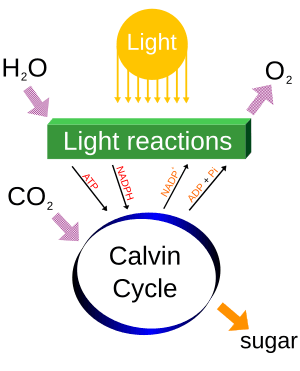Photochemistry facts for kids
Photochemistry is a cool part of chemistry that looks at how light makes chemical reactions happen. Think of it like magic where light gives the energy for things to change! There are lots of examples of this all around us, even in your own body.
For instance, photosynthesis is a super important process. This is how plants use sunlight to turn carbon dioxide and water into food and the oxygen we breathe. Also, when you spend time in the sun, your body uses light to make vitamin D, which is good for your bones!
Contents
How Light Powers Reactions
Most chemical reactions need a little push to get started. This push is called activation energy. Usually, this energy comes from heat. When you heat molecules, they move faster and bump into each other, causing reactions.
In photochemistry, light provides this energy. When a molecule or an atom absorbs light at a specific color (or wavelength), it gets excited. This means it has more energy and is much more ready to react with other things.
Light Changes Molecules
Light can also help reactions by changing the shape or symmetry of a molecule. Imagine a puzzle piece that needs to twist a certain way to fit. Light can make molecules twist and turn into new shapes, allowing them to react in ways they couldn't before. Scientists can even predict these changes using special rules called the Woodward–Hoffmann rules. Some reactions only happen with heat, while others need light to get going.
Light in Our Atmosphere
Light is super important in the air around us, especially in the upper parts of the atmosphere. Up there, there's a lot more UV light from the sun. This strong UV light helps chemical reactions happen that wouldn't normally occur closer to the ground.
For example, UV light can break apart ozone molecules. Ozone is made of three oxygen atoms. When UV light hits it, ozone can split into a regular oxygen molecule (two oxygen atoms) and a single oxygen atom. These new pieces can then react with other things in the atmosphere.
Images for kids
See also
 In Spanish: Fotoquímica para niños
In Spanish: Fotoquímica para niños





